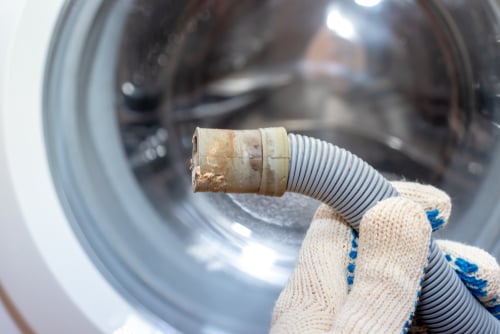Your water heater is one of those things you don't think about until it breaks. These maintenance tips will help you avoid a broken water heater this season.
Your water heater is one of those things you don't think about until it breaks. And the last thing you need during the holidays is water heater problems or worse—a broken water heater. Stay ahead of the game and use the information below to keep your water heater in working order all winter long.

Conduct routine maintenance
Traditional tank water heaters need to be drained and flushed twice a year because sediment can settle inside the tank. Sediment is material that settles at the bottom of water after it has been broken down by erosion or weathering. This material can affect the storage capacity of the tank and cause it to overheat.
Draining your water heater is quick and easy. Simply attach a garden hose to the drain valve on the bottom of your heater. Take a flathead screwdriver and open the valve. Once the water is finished draining, you can close the valve and remove the hose.
We'll show you just how easy it is in this video: How To Drain A Hot Water Heater.
It's also important to check your water heater's pressure relief valve, a key safety feature. When water is heated, it expands, and the excess pressure must be released, which is where the valve comes in. Many manufacturers suggest checking this it at least once a year.

What to do when there's no hot water
There's nothing more shocking than stepping into a cold shower on a chilly winter morning. Check the pan underneath your water heater for leaks. There shouldn't be any water or sediment in the pan.
Next, if you have a gas water heater, check your pilot light. If the light went out, the fix could be as simple as relighting it, but remember to use caution. Also, make sure your gas controls are completely turned on and that they’re connected firmly to the gas control unit. Most modern units have an igniter button that allows you to automatically relight your pilot light. However, if you have an older unit that needs to be manually lit, use extreme caution. If you aren't familiar with how to light a pilot light, call a professional. If your light won't stay lit, call a professional to come out and inspect the unit. The timing may be unfortunate, but this may be a sign that it's time to replace your unit.
If all of these things are in proper order, it's time to check the thermocouple. The thermocouple is a sensor that measures the water temperature. It consists of two wires made of different metals, which are welded together to create a junction. It senses if the pilot light is on to allow the release of gas. Make sure there are no cracks, holes, or corrosion on the mechanism. If everything looks good, try inspecting it with a multimeter. Only perform any maintenance if you're fully confident in your skills and educated about the process because gas water heater repair can be tricky and dangerous.
If you have an electric water heater, check the fuse box. If the circuit breaker has been flipped, try resetting it. If it continues to do this, you may need to contact an electrician to check for an electrical problem.

What to do when there's not enough hot water
You may need to turn up your hot water heater, but be careful not to turn it too high, especially if you have young children at home. The thermostat on a gas water heater has a dial on the outside of the tank. It can be adjusted by turning it to the desired setting. If you have an electric water heater, always turn off the power before working on it. Remove the thermostat panel cover and, using a flathead screwdriver, adjust the temperature setting. A good, safe setting is between 120–122 degrees Fahrenheit.
If you find that you still don't seem to have enough hot water for your family's usage, you may want to consider purchasing a larger or a secondary tank for your home.

Replacing your hot water heater
The average life of a gas water heater is 10 years (15 years for electric). If yours is old and needs to be replaced, there are a few things to consider before you purchase a new one.
For instance, if your family has grown and your tank doesn't seem to supply enough hot water for your needs, consider buying a larger tank. Check the FHR (first-hour rating) on the energy label of your heater. Follow this helpful rule of thumb:
Rule of Thumb Equation:
Number of people (or bedrooms) in household + 1 x 12
For a four-person household:
4 + 1 = 5
5 x 12 = a total of 60 gallons. This would be a sufficient size for a family of four or five people.
Another idea to consider is a tankless heater. Tankless heaters use less energy because they aren’t storing hot water all the time. When you turn on your hot water, the unit comes on and cold water is quickly heated through a heat exchanger before it's sent to your sink or shower.
Was this article helpful?






